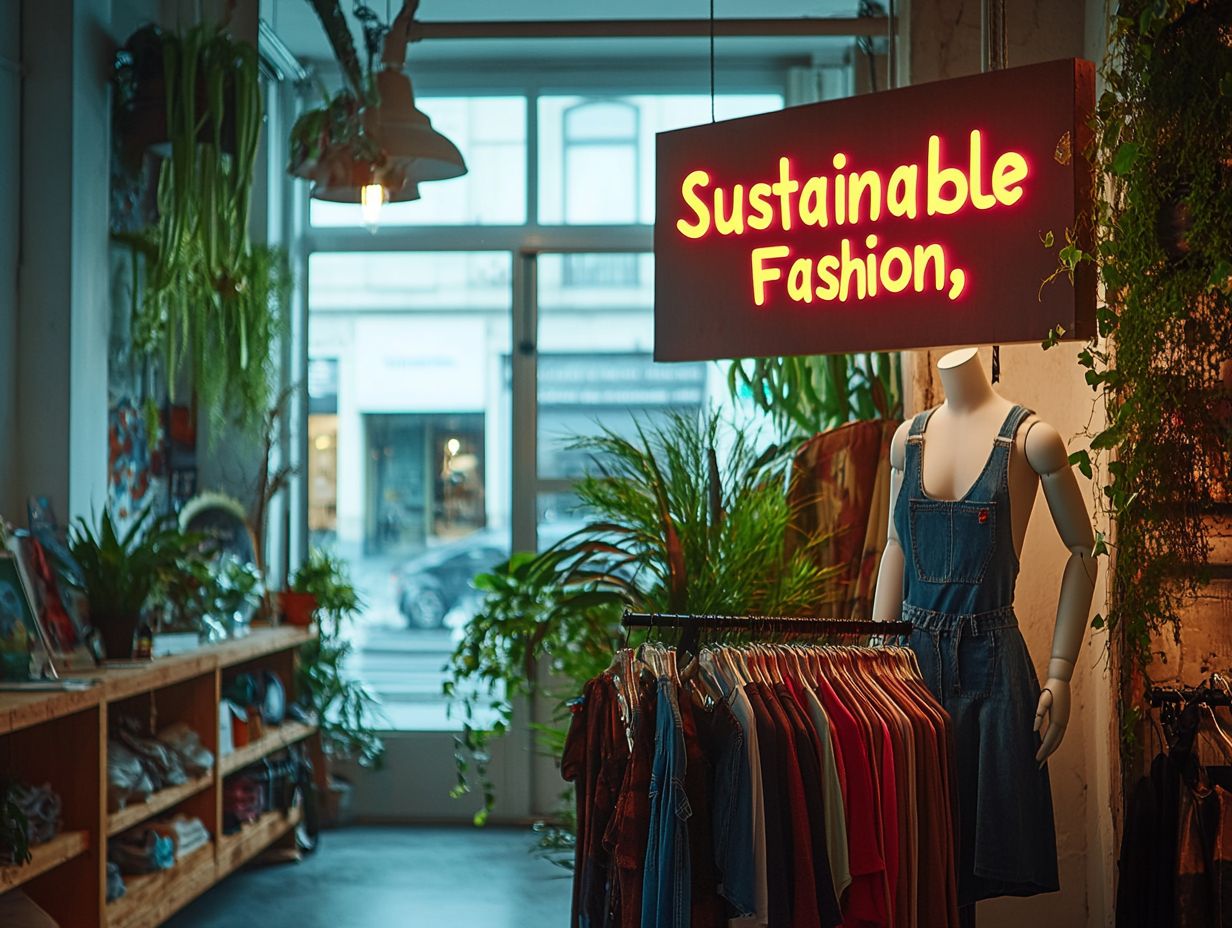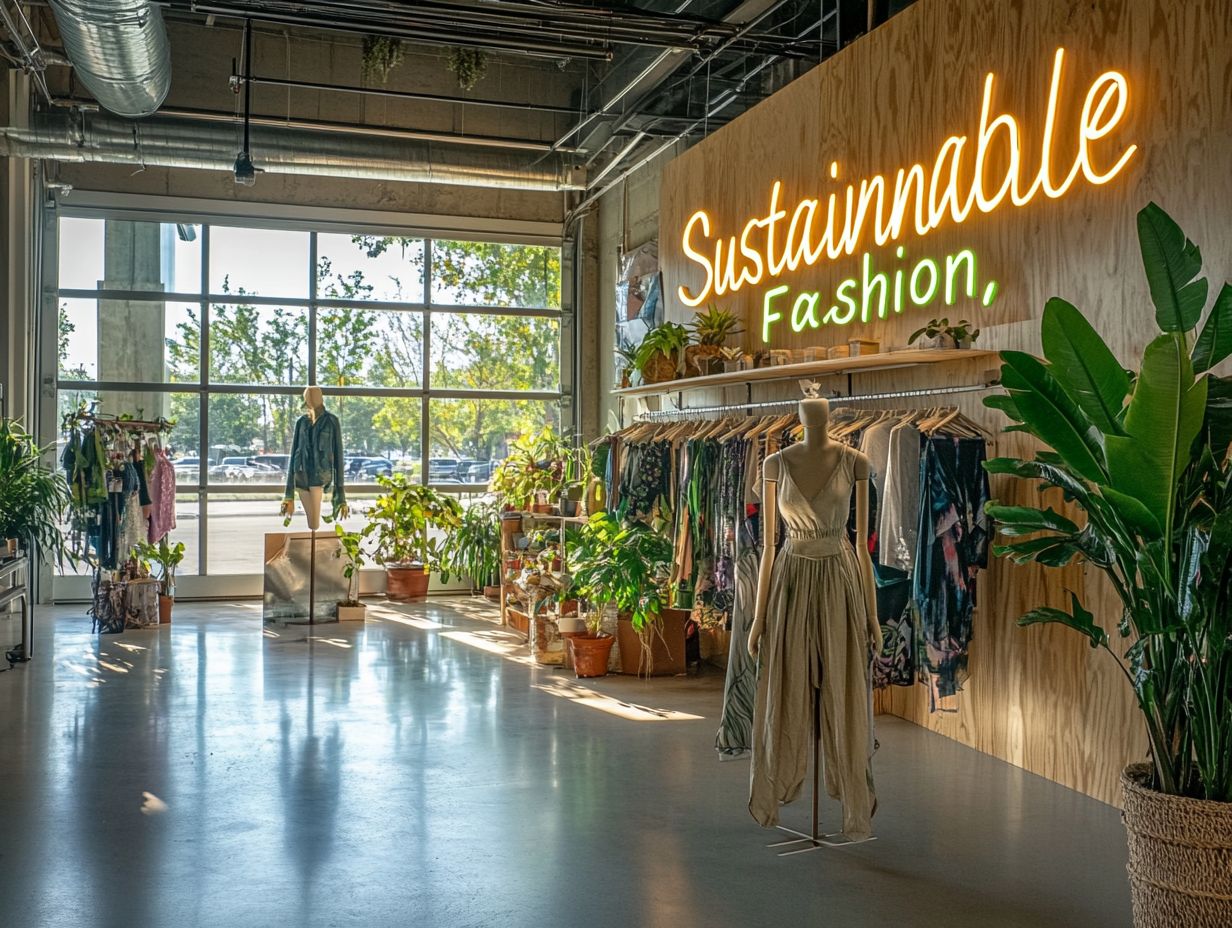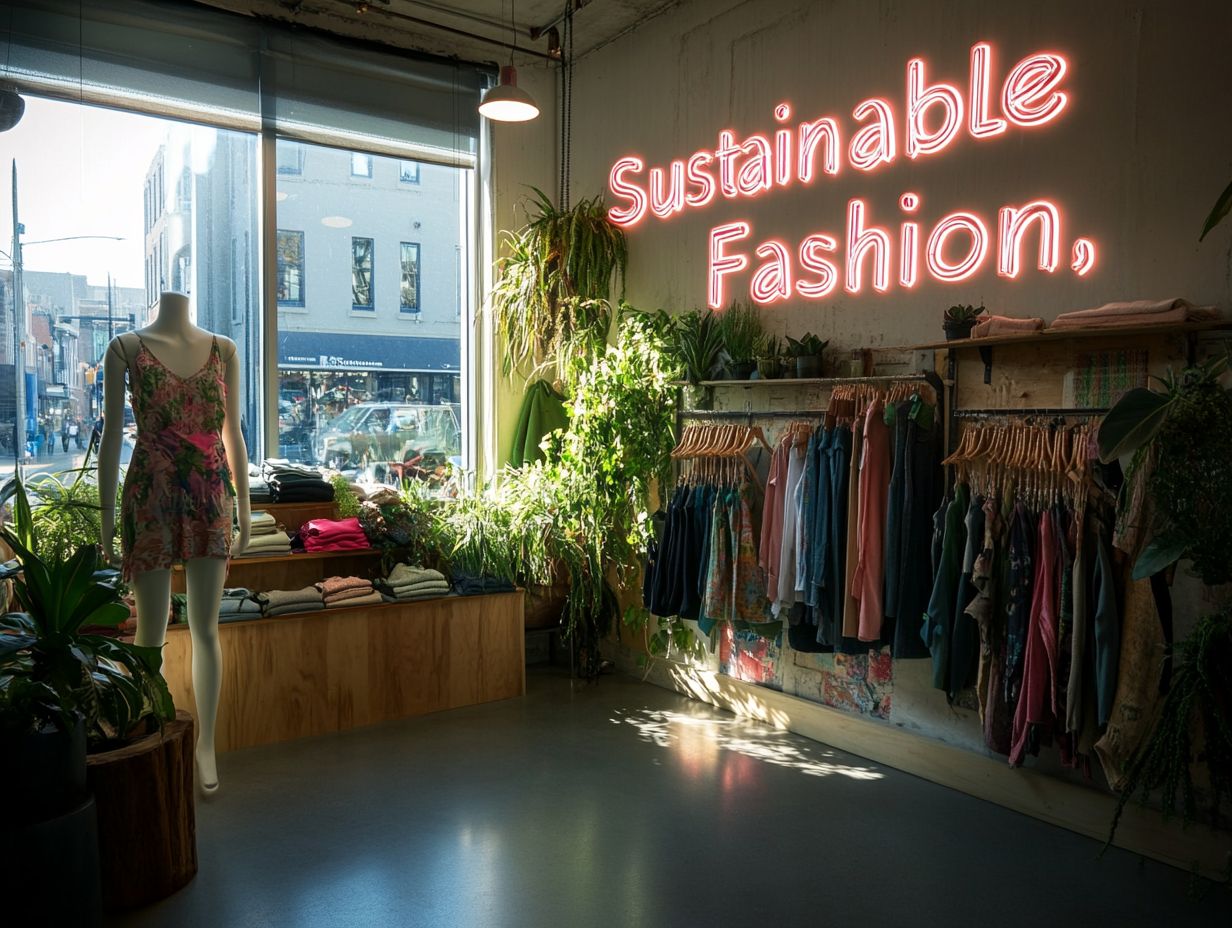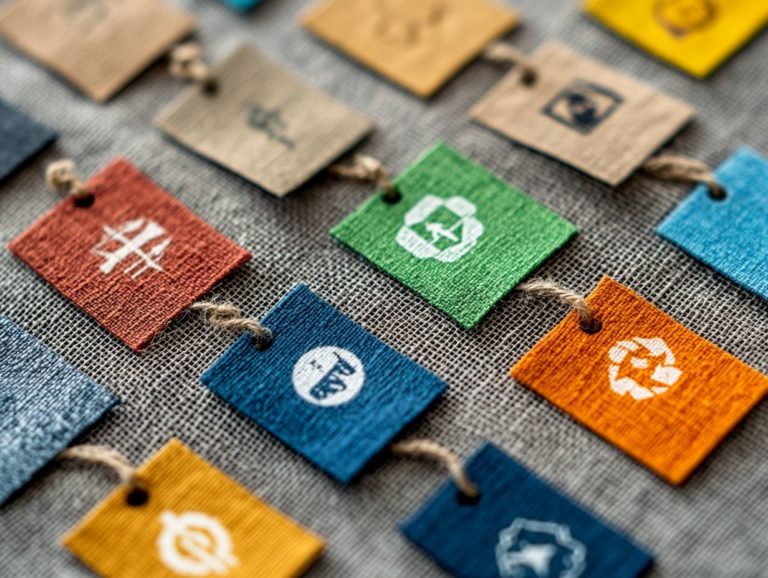5 Ways Fashion Brands Can Go Green
As the fashion industry confronts its environmental impact, more brands are recognizing the pressing need to adopt sustainability.
This article delves into five actionable strategies for fashion brands to shift toward greener practices. These strategies range from using sustainable materials to implementing ethical production methods.
It highlights the significance of these changes and examines the environmental repercussions of traditional fashion. Additionally, it illustrates how consumers can contribute to this essential transformation.
By the end, you ll uncover not just the necessity of going green but also the myriad benefits it brings to brands, communities, and our planet.
Explore with us the journey toward a more sustainable future in fashion.
Contents
- Key Takeaways:
- 1. Use Sustainable Materials
- 2. Implement Ethical Production Practices
- 3. Adopt Sustainable Packaging
- 4. Support Fair Trade and Local Communities
- 5. Educate Consumers on Sustainable Fashion
- Why Going Green Matters for Fashion Brands!
- Frequently Asked Questions
- What are 5 ways fashion brands can go green?
- Why Going Green is a Game-Changer for Fashion Brands!
- How can fashion brands incorporate sustainability into their designs?
- Can small fashion brands also go green?
- How can consumers support fashion brands that are going green?
- Are there any certifications or labels that indicate a fashion brand is eco-friendly?
Key Takeaways:

- Use eco-friendly materials to reduce the environmental impact of fashion production.
- Implement ethical practices to promote fair labor and working conditions in the fashion industry.
- Adopt sustainable packaging options to reduce waste and promote recycling.
1. Use Sustainable Materials
The fashion industry is increasingly placing a premium on sustainable materials. This shift reflects a commitment to eco-friendly practices and reducing environmental impact.
You can see this trend in the rise of organic cotton, which is cultivated without harmful pesticides and fertilizers. This not only minimizes water usage, but also promotes healthier ecosystems.
Bamboo also stands out for its rapid growth and low resource consumption. It enriches the soil and serves as a versatile textile that uses considerably less water than conventional cotton.
Recycled polyester is another game-changer, crafted from post-consumer plastic waste. This innovative approach transforms trash into valuable resources, helping to prevent pollution in our oceans and landfills.
Embrace these innovative materials now to lead the charge in sustainability! By adopting these forward-thinking options, fashion brands can effectively combat waste and resource depletion, aligning their efforts with broader sustainable initiatives that champion responsible consumption and keeping resources in use longer.
2. Implement Ethical Production Practices
Implementing ethical production practices is crucial for fashion brands that strive to enhance sustainability credentials and promote social responsibility.
This means embracing fair trade principles, ensuring that workers receive not only fair wages but also safe working conditions. Prioritize sustainable practices to minimize your environmental impact while addressing growing consumer demand for responsible sourcing.
Local sourcing is another key strategy, significantly reducing transportation emissions and helping to create a smaller carbon footprint. Transparent communication about your production methods enables consumers to make informed choices, deepening the connection between your brand and its audience.
When you take these important steps, you not only elevate your brand’s image but also foster positive change within communities and the environment.
3. Adopt Sustainable Packaging
Adopting sustainable packaging solutions is essential for fashion brands serious about reducing waste and minimizing their environmental impact.
Selecting biodegradable or recyclable materials is a significant stride toward eco-friendliness. This approach attracts a growing consumer base that highly values sustainability.
Companies like Reformation and Patagonia exemplify this trend, leading the way by using plant-based plastics and recycled materials in their packaging. They reduce reliance on single-use items, raising customer awareness about the importance of waste reduction.
By transparently sharing their sustainable practices, these brands encourage you to think about the lifecycle of packaging and its broader environmental implications. Implement these practices to foster a more responsible consumption mindset.
Take action today! Implement one of these strategies and share this article to inspire others in the fashion industry to join the movement toward sustainability.
4. Support Fair Trade and Local Communities

Supporting fair trade and local communities isn t just an ethical choice; it s a strategic advantage for your fashion brand. It builds credibility and fosters consumer loyalty.
By prioritizing fair trade practices, you ensure that workers receive fair wages, work in safe conditions, and have access to essential services. This approach benefits entire communities by promoting self-sufficiency and sustainable development.
You can actively champion ethical labor by:
- Sourcing materials from cooperatives that empower artisans.
- Investing in training programs that enhance skills.
These initiatives uphold the dignity of workers and resonate with conscious consumers who seek transparency and accountability. Aligning your business practices with fair trade principles nurtures local economies while strengthening your brand identity in a crowded marketplace.
5. Educate Consumers on Sustainable Fashion
Educating consumers about sustainable fashion is essential for creating demand for eco-friendly products. It elevates awareness of how their choices impact the environment. This understanding enables consumers to make informed decisions about the brands they support and the products they buy.
Brands that prioritize transparency can share their practices and highlight the sustainability of their materials. This fosters a deeper connection with consumers. Engaging storytelling and visual campaigns showcasing the lifecycle of garments effectively demonstrate the benefits of responsible consumption.
Brands that adopt innovative technologies like traceability tools illustrate their dedication to sustainable practices. They invite consumers to join this vital movement.
Why Going Green Matters for Fashion Brands!
The importance of fashion brands adopting green practices goes beyond compliance. It showcases a commitment to protecting our planet and society.
The industry grapples with challenges like a staggering carbon footprint and excessive water consumption. Embracing sustainable initiatives is essential. Switching to eco-friendly materials and processes minimizes environmental harm and crafts a compelling narrative. This shift builds brand loyalty as customers are drawn to businesses that align with their values.
Leading in green practices can spark innovation, encouraging companies to explore new techniques that enhance efficiency and reduce waste. This not only redefines industry standards but also paves the way for a more sustainable future.
What Are the Environmental Impacts of the Fashion Industry?
The environmental impacts of the fashion industry are staggering. The industry significantly contributes to carbon emissions, water usage, and the spread of microplastics in our ecosystems.
This sector accounts for about 10% of global carbon emissions more than all international flights and maritime shipping combined. Fast fashion has intensified these issues, fostering a cycle of overproduction and rampant consumption. This results in an astonishing 92 million tons of textile waste generated each year.
With many brands prioritizing quick turnarounds over sustainable practices, a staggering 80 billion garments are produced annually. This puts immense pressure on vital resources like water. To put it in perspective, approximately 7,500 liters of water are required just to make a single pair of jeans.
Act now! If we don t tackle these issues quickly, our planet’s future is in serious jeopardy. The health of our planet and the generations that follow will be at stake.
How Can Fashion Brands Incorporate Sustainability into Their Business Model?

You can effectively weave sustainability into your fashion brand s business model through a varied approach that highlights eco-friendly materials, renewable energy, and circular fashion strategies. This approach ensures that you reduce your environmental impact while connecting with a growing demographic of socially conscious consumers.
Take a page from brands like Patagonia, which has long championed the use of recycled materials. Also, consider Stella McCartney, known for its significant strides in ethical sourcing and organic cotton utilization.
Look to companies like Adidas, which is leading the charge by adopting renewable energy across their supply chains. This commitment demonstrates how sustainability can lead to tangible operational changes. Additionally, it’s crucial to be aware of practices such as how to spot greenwashing in fashion brands. Embracing circular fashion initiatives is another effective strategy; think of brands like Eileen Fisher, which takes back its clothing to ensure it doesn’t end up in landfills.
By adopting these practices, you can position your brand as a leader in the sustainable fashion movement.
What Are the Benefits of Going Green for Fashion Brands?
Embracing a green ethos can unlock a wealth of benefits for your fashion brand. You can achieve heightened brand loyalty, increased consumer awareness, and a distinct competitive edge in a market that increasingly prioritizes sustainability.
Integrating sustainable practices into your operations allows you to significantly reduce operational costs, particularly through energy-efficient processes and waste reduction initiatives. This commitment enhances your brand’s credibility and opens doors to innovative product development, spotlighting environmentally friendly materials that resonate with a more conscientious audience.
Emphasizing ethical labor practices enhances your brand’s perception. This strategy appeals to consumers who value transparency and social responsibility in their purchasing choices.
What Are Some Examples of Sustainable Fashion Brands?
Numerous brands exemplify sustainable fashion through their unwavering commitment to eco-friendly practices, ethical labor, and innovative materials. They set impressive benchmarks for the industry.
Patagonia: The Pioneer of Environmental Responsibility! They’ve long been champions of environmental responsibility, using organic cotton and recycled fabrics to minimize their ecological footprint.
tentree: Going the Extra Mile! This brand plants ten trees for every item sold, actively combating deforestation while supporting biodiversity.
Fair Indigo: Shining a Light on Fair Labor Practices! They offer clothing made from organic cotton to ensure workers are treated ethically and receive a living wage.
Quince: Focusing on Renewable Energy! They craft timeless, accessible fashion using high-quality, sustainable materials and renewable energy sources.
These brands are not just participating in a trend; they are leading the charge toward a greener future.
What Can Consumers Do to Support Sustainable Fashion?
You play a pivotal role in supporting sustainable fashion by making informed purchasing decisions that prioritize eco-friendly practices and ethical labor standards.
By choosing to support brands that employ sustainable methods and materials, you can significantly impact the industry. Advocating for reduced waste—whether that means opting for quality over quantity or participating in clothing swaps—encourages a shift toward a more responsible fashion culture. You can also learn how to create a zero waste fashion plan to further enhance your efforts.
Educating yourself about the implications of fast fashion and its environmental footprint enables you to make better choices. This awareness drives demand for transparency and compels brands to operate more sustainably, ultimately fostering a more environmentally friendly and socially responsible fashion ecosystem.
Join the movement! Your choices matter, so shop smart and support sustainability today!
Watch this video to learn about sustainable fashion practices!
Frequently Asked Questions

This section addresses common queries about sustainable fashion.
What are 5 ways fashion brands can go green?
1. Use sustainable materials: Fashion brands can significantly reduce their environmental impact by utilizing sustainable materials like organic cotton, recycled polyester, and bamboo. These alternatives are eco-friendlier compared to traditional materials such as conventional cotton and polyester.
2. Implement ethical production practices: Another vital step is ensuring ethical production practices, including fair wages and safe working conditions. This not only benefits workers but also contributes to a healthier planet.
3. Reduce energy and water usage: Fashion brands can go green by lowering energy and water consumption. They can achieve this through renewable energy sources, more efficient production processes, and water-saving techniques.
4. Minimize waste: Minimizing waste during production is crucial for sustainability. Brands can recycle and repurpose fabric scraps, use biodegradable or recyclable packaging, and adopt a system where products are reused and recycled to minimize waste. For more insights, check out this guide on how to build a sustainable fashion brand.
5. Partner with sustainable organizations: Fashion brands can also collaborate with organizations that promote eco-friendly practices. Such partnerships can amplify awareness and lead to a larger positive impact in the fashion industry.
Why Going Green is a Game-Changer for Fashion Brands!
Going green is crucial for fashion brands to ensure a sustainable future. The fashion industry has a significant negative impact on the environment, contributing to pollution, excessive water usage, and climate change. By adopting eco-friendly practices, brands can lower their carbon footprint and promote a healthier planet.
How can fashion brands incorporate sustainability into their designs?
Fashion brands can embed sustainability into their designs by selecting eco-friendly materials and ethical production practices. They should also consider the entire life cycle of a garment, using durable materials and designing for longevity, creating items that can be easily recycled or repurposed.
Can small fashion brands also go green?
Absolutely! Small fashion brands have the opportunity to make substantial changes by implementing the same sustainable practices as larger brands. They often have the advantage of agility, enabling them to adapt quickly and create a direct positive impact on their production processes.
How can consumers support fashion brands that are going green?
Consumers can play a significant role in supporting eco-friendly fashion. By educating themselves about sustainable fashion, choosing to purchase from aligned brands, and advocating for more eco-friendly practices, they can help pave the way for a more sustainable fashion industry.
Are there any certifications or labels that indicate a fashion brand is eco-friendly?
Yes, various certifications and labels signify that a fashion brand is eco-friendly. These include the Global Organic Textile Standard (GOTS) and labels like Fair Trade or B Corp. Brands that receive these certifications meet specific standards for environmental and social responsibility.






